#Civics education
Text
“MILIEU” AS A COMMONPLACE, III
To give readers insight about the challenges attached in developing a responsible curriculum, this blog has referred to William Schubert’s commonplaces of curriculum.[1] In that endeavor, the blog has reviewed all of the commonplaces and how they relate to any suggested curricular changes one might promote for civics education. It still has some commentary on the last of the commonplaces, milieu, to share. The last posting commented on the social expectations of schools and this one will address schools’ socio-economic concerns which undergird their base.
As explained earlier in this blog, Jean Anyon found the types of instruction and curriculum that schools offered were highly associated with the economic status of the children and adolescents who attended those individual schools.[2] In “working class schools” the tendency was for students to be exposed to instruction relying on rote work with little or no explanation, which leads to mechanistic learning.[3]
“Affluent professional schools” or “executive elite schools,” on the other hand, were much more apt to utilize instruction that had students engage in creative activities and independent work. This latter type of work is what is being proposed in this blog’s promotion of the liberated federalism mental construct. Such instruction allows students to develop analytical skills useful in adult life.
The consequence of this difference is that through the schools’ hidden curricula, they tend to reinforce the social and economic inequalities that already exist. Workers’ children are taught the skills and disciplinary dispositions expected of them at the workplace and managers’ and problem-solvers’ children and adolescents are expected to learn the skills they need to take the employment positions of their parents. This includes such positions as management and consulting work.
Jere E. Brophy, in the latter years of the past century, argued that the dichotomy of experience is not only one experienced in school, but further experienced in the home. The reviewed sources of this century do not reveal improvement[4] but describe how upper income parents, who usually hold more intellectually demanding employment, fill their households with discussion and conversation that have a more abstract quality. Brophy wrote:
I take the term “disadvantaged” to imply two things about a child’s background: (1) poverty and (2) gaps and limitations … so it should not be taken to imply limited potential, sensory or motor deficits, or learning disabilities … Disadvantaged backgrounds limit students’ readiness for school activities in both quantitative and qualitative ways. …
In addition to … quantitative limitations in disadvantaged students’ background experience, there are gaps and qualitative limitations in their development of cognitive and metacognitive tools for processing and making sense of their experience, transforming and storing this information in a form of codified knowledge, and assessing and applying it in relevant future situations.[5]
Of course, this condition of treating different socio-economic groups differently in terms of the educational advantages provided is an affront to the nation’s stated political value of equality.
This blogger, in a published article, argued that the educational product presented to lower income students should be different in terms of the level of abstraction in which the material is presented.[6] This is not to avoid abstraction but to recognize the exposure these students have had. This demands curricular constructs of content that are flexible enough to meet the different levels of abstraction that are of potential utilization. The judgment of this account is that its proposed model, the liberated federalism model, offers such flexibility.
The model is open-ended in terms of the specific conditions which might be portrayed under its use. Challenging political situations can vary from relatively simple concerns to highly complex ones. The portrayal of the compact-al, federated union can also vary in complexity. But its basic components are easy to understand and amply demonstrable by the experiences of any youngster.
Bonds formed among young friends in primary groups, for example, often exhibit the characteristics described under the concept, fraternal ethos.[7] Therefore, the judgment of this account is that the use of the liberated federalism model can meet the demands of the different income groups by allowing teachers or material developers to gear the material to appropriate levels of abstraction and therefore, provide the pathway to more meaningful and insightful understanding of governance and politics.
[1] William H. Schubert, Curriculum: Perspective, Paradigm, and Possibility (New York, NY: MacMillan Publishing Company, 1986). The commonplaces can be defined as follows:
The subject matter refers to the academic content presented in the curriculum.
The teacher is the professional instructor authorized to present and supervise curricular activities within the classroom setting.
Learners are defined as those individuals attending school for the purpose of acquiring the education entailed in a particular curriculum.
Milieu refers to the general cultural setting and ambiance within the varied social settings found at the school site.
Upon reflection, these commonplaces prove to be helpful in asking insightful questions.
[2] Jean Anyon, “Social Class and the Hidden Curriculum of Work,” in Curriculum: An Introduction to the Field, 2nd Edition, edited by James R. Gregg (Berkeley, CA: McCutchan, 1988), 366-389 AND for a more general overview on the ways financial resources have on education see “Does Money Matter in Education? Second Edition,” Albert Shanker Institute (2023), accessed October 28, 2023, URL: https://www.shankerinstitute.org/resource/does-money-matter-education-second-edition#:~:text=Schooling%20resources%20that%20cost%20money%2C%20including%20smaller%20class%20sizes%2C%20additional,positively%20associated%20with%20student%20outcomes.
[3] For a granular review of how money affects the quality of education students of various income levels receive, see Henry M. Levin, “On the Relationship Poverty and Curriculum,” North Carolina Law Review, 85, 5 (June 1, 2007), 1383-1418, (quotation below, page 1403). Here is a sample of that work:
The signs of different expectations are subtle but evident, even at the elementary school level. Schools serving lower-income students often stress following directions, while the middle class students are charged with critical analysis of school subjects." Teachers of low income students often place more emphasis on discipline, and children's experiences are circumscribed because of concerns that they will not behave appropriately if given challenging or enriching experiences or provided with too much independence.
[4] For example, see “Unequal Opportunities: Fewer Resources, Worse Outcomes for Students in Schools with Concentrated Poverty,” Commonwealth Institute (1921), accessed October 31, 2023, URL: https://thecommonwealthinstitute.org/research/unequal-opportunities-fewer-resources-worse-outcomes-for-students-in-schools-with-concentrated-poverty/.
[5] Jere E. Brophy, “Effective Schooling for Disadvantage Students,” in Better Schooling for the Children of Poverty: Alternatives to Conventional Wisdom, edited by Michael S. Knapp and Patrick. M. Shields (Berkeley, CA: McCutchan Publishing Corporation, 1991), 211-234, 211-212.
[6] Robert Gutierrez, “Teaching Secondary Social Studies to Low and Moderate Achievers: A Modest Proposal,” The Social Studies, July/August, 149-154.
[7] For readers new to this blog, the liberated federalist view promotes a view of state-building which depends on a sacred (either secularly or religiously defined) agreement in which founding parties come together to formulate the resulting polity. In turn, it counts of its citizenry to maintain a relatively high level of federation among its members. Hence, a “fraternal ethos” becomes important. The problem is that this nation has veered away from such leanings and has adopted a natural rights view with its high level of individualism to define how the citizenry defines governance and politics.
#liberated federalism#socio-economic factors#working class#abstract content#civics education#social studies
2 notes
·
View notes
Text
Promoting Civic Engagement: Top Civics Courses to Boost Your Knowledge and Participation
iCivics: iCivics is a nonprofit organization founded by retired Supreme Court Justice Sandra Day O'Connor that provides free, online civics education resources for K-12 students, including interactive games, lesson plans, and teacher resources.
Harvard's Justice and Civics course: Harvard's Justice and Civics course is a free, online course that explores the role of civic engagement and the justice system in promoting social change. The course is open to anyone and includes video lectures, readings, and quizzes.
The Democracy Project: The Democracy Project is a series of free online courses offered by the University of California, Irvine, that cover a range of topics related to democracy, including political theory, constitutional law, and public policy.
The Civic Engagement Initiative: The Civic Engagement Initiative is a program offered by the Center for Civic Education that provides professional development opportunities for teachers to help them integrate civic education into their curricula. The program includes online courses, webinars, and workshops.
Youth in Front: Youth in Front is a program offered by the Youth Activism Project that provides online courses and training programs for young people who are interested in activism and civic engagement. The program includes training on how to organize campaigns, engage with elected officials, and advocate for change.
By promoting these and other civics courses, we can help to foster a more engaged and informed citizenry, better equipped to participate in the democratic process and make a positive impact on our communities and society as a whole.
#Civics education#Civic engagement#Democracy#Political literacy#Youth activism#Online learning#Professional development#Social change#Community involvement#Teacher resources
3 notes
·
View notes
Text
when you call your reps to ask them to pretty please stop taking away your rights, remember:
In deep red areas you're a republican who is thinking of voting for someone else if they don't vote what you want on this specific bill because it impacts your republican ideals so very much
In swing states you're an undecided voter who's gonna go blue if they don't vote how you like
remember to call because that way their phone is going off and their peers can hear it because their offices are close together (emails and letters don't work like that), so it can rattle them if they get high volumes. remember that you gotta make them feel like they're losing something.
#civic engagement#democracy#anti facist#abortion#education#lgbtq#call your reps#florida#tennessee#united states#go through comments and tags#lots of useful information in there
68K notes
·
View notes
Text
Squaring the circle. Our democracy is imperfect, and should be acknowledged as such. If we don’t learn from our mistakes as well as our successes, how can we improve?
0 notes
Text
By Aizaz Gill
Northeast Times Opinion
May 4, 2023
The 2022 midterm elections results demonstrated that more Pennsylvania voters are rejecting partisan rancor and seeking common ground. While this is a sign of hope for our democracy, there is still much work to be done to address the divides in our communities and workplaces. One important step for reducing polarization is for communities across the state to invest more in civic education for all K–12 students.
As a nation, we are currently facing a crisis of civic literacy. A 2022 study from the University of Pennsylvania showed that only 47% of American adults can name all three branches of government. According to the National Assessment of Educational Progress’s National Report Card, in 2018 only 24% of students performed at or above NAEP proficiency standards in civics.
This is the result of several decades of under investment in civic education. Currently, the federal government invests a mere 50 cents per K–12 student in civic education compared to 54 dollars per K–12 student for STEM. Both are important and worthy of public investment. This deficiency in civics funding contributes to the political polarization and dysfunction plaguing America today.
Businesses are concerned that too many young people lack a basic understanding of the Bill of Rights, the Declaration of Independence and the responsibilities of being a citizen. This limited education about our democratic system makes people more vulnerable to misinformation and sowing distrust in the electoral process, which are destructive to our country’s social cohesion and economic competitiveness.
Read more.
1 note
·
View note
Text
Education On The Chopping Block
Education On The Chopping Block
The education of our young people is probably the single most critical issue, after climate change and the environment, that our nation faces today. In recent decades, we have seen the decline of our public education system. Schools have stopped or cut back on teaching such things as civics, social sciences, philosophy, and even literature, trading them for a more technical education based on…

View On WordPress
#civics education#Doug Ducey#Hillsdale College#Kari Lake#Kristi Noem#Larry Arnn#Liberal Arts Education#Ron DeSantis#whitewashing history
0 notes
Text
A brief summary of how Education fails Boys
I saw people sincerely questioning and minimizing the current struggles boys face in education.
So, I wanted to collect some relevant information, with sources. All of these are from the past couple of years, from 2021 onward.
Girls have more difficulty accessing education and are more likely than boys to be out of school at primary level. However, boys are at greater risk of repeating grades, failing to progress and complete their education, and not learning while in school. Globally, 128 million boys are out of school. That’s more than half of the global out-of-school youth population and more than the 122 million girls who are also out of school.
The Leave no child behind: Global report on boys’ disengagement from education shows that boys are increasingly left behind in education. They are at greater risk of repeating grades, failing to progress and complete their education, and not learning while in school. While previously boys’ disengagement and dropout were concerns mainly in high-income countries, several low- and middle-income countries have seen a reversal in gender gaps, with boys now lagging behind girls in enrolment, completion and learning outcomes. Boys are more likely than girls to repeat primary grades in 130 countries, and more likely to not have an upper secondary education in 73 countries. At tertiary level, globally only 88 men are enrolled for every 100 women.
In 1970, women only made up 42 percent of the college population. Today, the roles have essentially reversed. The U.S. Department of Education estimates men to make up 43 percent of enrolled individuals in college. And this crisis impacts minority populations even more: only 36 percent of Black and 40 percent of Hispanic bachelor degree recipients are male.
This is not an issue of colleges neglecting to admit men at an equal rate. Rather, colleges are receiving fewer applications from men than women. In 2010, only 44 percent of college applications were from men and that number has been steadily declining since. The decrease in male applicants is a sign that men are discouraged from pursuing higher education at a disproportionately high rate.
These statistics point to a larger, systemic problem. The American education system perpetuates a series of gender norms that cause significant harm to children; boys are impacted by these expectations in a way that tends to be overlooked. The stereotype that boys have a higher propensity to misbehave has led to the over-punishment of boys in the classroom.
Boys are facing key challenges in school. Inside the effort to support their success
An APA task force is spotlighting the specific issues and recommending evidence-based ways to enact swift change
At school, by almost every metric, boys of all ages are doing worse than girls. They are disciplined and diagnosed with learning disabilities at higher rates, their grades and test scores are lower, and they’re less likely to graduate from high school (Owens, J., Sociology of Education, Vol. 89, No. 3, 2016; Voyer, D., & Voyer, S. D., Psychological Bulletin, Vol. 140, No. 4, 2014; “The unreported gender gap in high school graduation rates,” Brookings, 2021). These disparities persist at the university level, where female enrollment now outpaces male enrollment by 16% (Undergraduate Enrollment, National Center for Education Statistics, 2022).
“The gap between boys and girls is apparent from very early on,” said developmental psychologist Ioakim Boutakidis, PhD, a professor of child and adolescent studies at California State University, Fullerton. “The disparities not only exist across the board—from kindergarten all the way to college—but they are growing over time.”
For boys of color, that gap is even larger. They face suspension and expulsion from school at almost five times the rate of their White male classmates and are even less likely to finish high school or college (“Exploring Boys’ (Mis)Behavior,” Society for the Psychological Study of Men and Masculinities, 2022 [PDF, 261KB]).
The implications of these disparities are huge. Doing poorly at school is strongly associated with major challenges later in life, including addiction, mental and physical health problems, and involvement with the criminal justice system—problems that also have ripple effects on society at large. In the United States, getting at least a college degree may be the one remaining, relatively stable ticket to a decent life, Boutakidis said.
In a recent New York Times essay, “It’s Become Increasingly Hard for Them to Feel Good About Themselves,” Thomas Edsall reviews a variety of research studies highlighting the plight of young men in the United States. As a front-line educator who has worked in boys’ schools for 30 years and served as the head of a boys’ school for the past 20 years, I’ve been an unhappy witness to this dilemma.
Data supports the claim that boys are falling behind, and dramatically so. For example, there is a growing gender gap in high school graduation rates. According to the Brooking Institution, in 2018, about 88% of girls graduated on time, compared with 82% of boys.
For college enrollment, the gender gap is even more striking, with men now trailing women in higher education at record levels. Last year, women made up 60% of college students while men accounted for only 40%, according to statistics from the National Student Clearinghouse. College enrollment in the United States has declined by 1.5 million students over the past five years, with men accounting for 71% of that drop.
41 notes
·
View notes
Text
call me crazy but i don't think you need to be a martyr to be educated
#been seeing some atrocious takes lately and i just want to say that there's a huge difference between educating yourself and doomscrolling#ppl saying that 'deciding not to watch videos of [x horrible atrocity] is a form of privilege'#because you're privileged not to be in that situation and can live your life normally. but there is a HUGE difference#between learning about an issue versus subjecting yourself to traumatic footage just because you have a 'civic duty.' and let me say.#you have a duty to be aware and educated. but you also have a duty to take care of yourself. your mental health and wellbeing.#your screentime. et cetera.#fucking crazy how people think that refusing to watch others suffer is some form of excessive ignorance or privilege. like. what.#willful ignorance is bad yes but you can educate yourself without sabotaging your own mental state.#and shockingly? that doesn't make you a bad person.
12 notes
·
View notes
Text

making lessons in school as humans!
(also they havent had a ref sheet. maybe i need help for this)
#lessons as a human#lesson human#mathematics#civic#physics#art music#physical education#transmasc#asexual#aroace#aromantic#pansexual#ace#transfem#bisexual#art#artists on tumblr#artwork#a new fandom#bigender
9 notes
·
View notes
Text
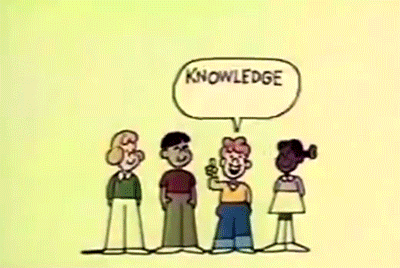
Hey kids,
In the United States, there are three branches of government: Legislative, Executive, and Judicial. The Legislative Branch is Congress, and Executive, the President. Every few years, we vote in elections to choose those people. But the Judicial is special: when one of the nine Justices of the Supreme Court retires or passes away, the Senate, part of Congress, chooses their replacement. Then, they’re there for life.
In 2022, the Supreme Court chose to overturn Roe v. Wade, which previously found a right to abortion is protected by the Constitution. Now, do you remember who the Supreme Court is? That’s right, the Judicial! They get chosen for life. So, that decision was not made by Congress or the President. Constitutional rights also require 38 states and a supermajority in Congress to approve, so there is not currently a way to restore this right aside from the Court.
So what do we say when people blame President Biden for the loss of the right to abortion?
#discourse#education#civics#government#abortion#basic knowledge#some of you guys arent american or done with school so my tone is not directed towards you#disinformation#propaganda#misinformation#correcting disinfo#i hate the internet#i hate tumblr#i might log off again for crying out loud#election 2024#voting#joe biden
7 notes
·
View notes
Text
CRITQUE OF THE NATURAL RIGHTS VIEW, II
With the last posting, this blog has resumed its posting schedule of Tuesdays and Fridays. With this posting, the blog picks up its critique of the natural rights view. As a quick review, the natural rights mental construct is the dominant view of governance and politics in the US. In the last posting (the first after a three-month break), this critique was introduced by outlining a list of points it will develop.
The first was:
The construct has a limited view of decision-making. This is important because the construct’s position on decision-making is narrowed to transactional aspects of governance and politics. The position on decision-making serves as one of the construct’s basic operating assumptions.
Let this posting describe and explain this shortcoming.
A political systems model is an extensive and comprehensive view of the political life one finds in a nation. As the mode by which the natural rights view encourages students to go about studying politics, it is exceedingly useful if a student makes an assumption that there are extensively shared goals and values within the political system. If these exist, then a further assumption or prior condition is possible.
In such a nation, behavioral studies’ reliance on people being apt to make rational decisions will be the normal course of decision-making. That is, when people are confronted with a decision, they will basically ask themselves what choice affords them the most benefit for the least cost. Choices will be made toward those possibilities in which the marginal benefits exceed marginal costs.
For example, should one turn on the TV? Does what is on TV accrue more benefit than expending the energy to turn the set on or to do something else? Of course, calculations come into play as to the possibilities for benefits and costs with alternative choices in an uncertain world.
This analysis can be highly involved, but the mind handles the calculations fairly efficiently given the complexity of the choice and the information a person has at the time of the decision. But in any event, certain stable conditions need to prevail for this type of calculation to be possible and should be considered.
So, how is this relevant? Theoretical work in the field of political studies which has been based on these considerations is advanced by Anthony Downs.[1] In his writing, the concern is focused on the role the above mentioned marginal or rational thinking has in political systems study. The judgement here is that the rational assumption is a basic one for those students who employ the political systems approach. Or if one wishes to delve a bit further, what is assumed are those elements of a political culture to be present and viable when such decisions are being made.[2]
Daniel Moynihan shares this view: “… American social science had pretty much settled on a utilitarian model in which behavior is explained by expectation of things yet to happen. Rewards and punishments.”[3] This critique is not that political systems and other derived models are crude behavioral efforts – all of them have taken pains to address other factors beyond rewards and costs – but the biases toward that sort of calculation are entrenched in systems theorizing and in their derived research.
And therefore, their concerns for the formulation of goals and values – normative factors – seem wanting. This is so if one considers that there are two sides to decision-making. One side is the way the individuals see the benefits and costs before them, and the other is the development of the goals and values that establish what is judged to be beneficial and costly.
This latter part of decision-making is mostly ignored in the political systems approach to the study of politics. In most analyses, these aspects are taken as given, yet this critique deems these concerns essential if understanding and predictability are the ultimate goals of any given study. The approach, by so assuming, adds to its reductionist tendency of only taking those factors immediately present when such decision-making takes place.
Money plays a role in these considerations. Money is not an end in itself. It is converted into many different things and conditions of life. When one says, “it’s only money,” one does not do money justice. Money can mean peace of mind or a child’s health. It can convert into recreation or education. It can mean an untold number of things. As such, it can represent goals and values.
To add to this situation, money can be counted in equal units. Therefore, there is a tendency for money to create an illusion. The illusion is that money can represent goals and values. It can be seen in different guises as a won contract or a promotion at work. Money then seems to be the universal goal or value. In capitalist economies, the attainment of money seems to permeate all aspects of life. Sports, religion, and education seem to be measured in monetary terms.
But upon reflection, people know that not all is for sale or measurable by a monetary value. The significance of this is that systems’ view of counting on benefits and costs is further entrenched by the role of money. Not only are all people after money, or so the assumption goes, but one can measure how much money – reward or benefit – it takes to get people to do something. There is a certain theoretical cleanliness about this view.
In short, what is being suggested is that human behavior, much less human thinking, emoting, planning, and other non-observable human “actions” are highly complex and involved and that doesn’t even consider what is at the subconscious level. This posting ends with this introduction to decision-making and will continue with this point of contention in the next posting with a quote by Philip Selznick.
[1] Anthony Downs, An Economic Theory of Democracy (New York, NY: Harper and Row Publisher, 1957).
[2] See Jurgen R. Winkler, “Political Culture,” Britannica (n.d.), accessed February 9, 2023, https://www.britannica.com/topic/political-culture. Winkler writes,
American political scientist Lucian Pye defined political culture as the composite of basic values, feelings, and knowledge that underlie the political process. Hence, the building blocks of political culture are the beliefs, opinions, and emotions of the citizens toward their form of government.
… The classic study of political culture is The Civic Culture (1963) by American political scientists Gabriel Almond and Sydney Verba.
He goes on to point out that some studies look closer at subcultures within nations, but the effect is the same; it provides the landscapes by which decision-making can proceed as described here.
[3] Daniel P. Moynihan, Pandemonia: Ethnicity in International Politics (New York, NY: Oxford University Press, 1993), 30.
3 notes
·
View notes
Text
The Cost of Ignorance: The Consequences of Removing Civics Education from Public Schools
In recent years, many have voiced concerns about the state of civics education in the United States. The removal of civics education from public schools has led to a generation of Americans who lack knowledge of their government, their rights, and their responsibilities as citizens. This lack of understanding is not only harmful to individuals but also to the very fabric of American democracy.
The removal of civics education from public schools began in the 1960s as schools focused more on standardized testing and core subjects like math and science. As a result, civics classes and social studies were often reduced or eliminated entirely. In recent years, this trend has continued, with fewer and fewer schools offering civics classes or requiring students to learn about government and citizenship.
The consequences of this lack of civics education are apparent. Surveys show that a majority of Americans cannot name the three branches of government or identify the basic principles of the Constitution. This ignorance is not limited to individuals either, as it has a direct impact on the functioning of American democracy.
Without a basic understanding of how government works, citizens are unable to effectively participate in the political process. They may be unable to engage in informed debates, make informed decisions about political candidates and issues, or even understand how to vote or run for office themselves. This lack of knowledge can also lead to apathy and a lack of interest in politics altogether, which can be detrimental to the health of democracy.
Fortunately, there are solutions to this problem. One potential solution is to increase funding for civics education in public schools. This could involve hiring more teachers, creating new civics curricula, and providing training for teachers to ensure they are equipped to teach civics effectively. Another solution is to make civics education mandatory in all public schools, ensuring that all students have access to the knowledge and skills necessary to be informed and engaged citizens.
The cost of ignorance is too high for our democracy to bear. It is time for educators, lawmakers, and citizens alike to recognize the importance of civics education and take action to ensure that future generations of Americans have the knowledge and skills necessary to participate fully in our democracy.
#civics education#American democracy#public schools#government#citizenship#informed citizens#political process
2 notes
·
View notes
Link
So these are the ways the right-wing, white “Christian” nationalist agenda is being written into Florida’s new “patriotic” civics education standards. The slides shown are bad enough but according to the article:
Educators interviewed by the Herald/Times said that most of their concerns took place during the explanation of the materials.
Below are a few of the troubling slides from the Florida Department of Education’s (DE) training that grossly distort American history to serve this right-wing agenda. [NOTE: all red underlining in these slides was added.]
Dismantling the Separation of Church and State
The slide below shows how Florida’s DE wants it taught as FACT that the Founders didn’t want a “strict separation of church and state.”
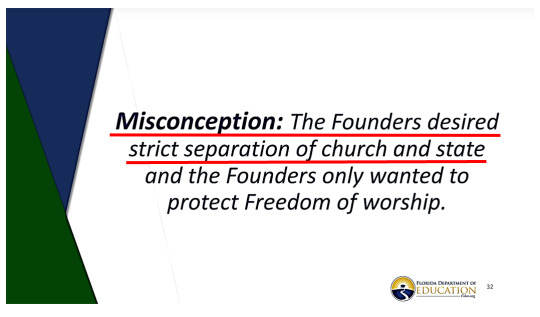
It seems to me that the Florida DE is trying to pass off as TRUE a right-wing “Christian” interpretation of the Founders’ intent. In reality, there is actually a lot of evidence that the Founders wanted a “strict” separation of church and state.
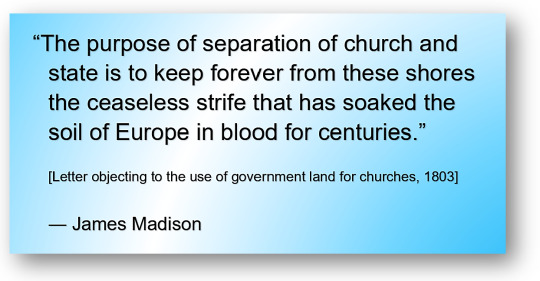
The Florida DE also apparently wants to teach that the Founders believed that religion (specifically Christianity) provided the necessary moral foundation for the nation to govern itself.

Although one of the Florida DE slides mentions Rhode Island accepting “religious refugees from Massachusetts” there is NO mention in the slide that Roger Williams established religious freedom in Rhode Island for people of any faith. This freedom was written into Rhode Island’s 1663 charter. (However, it is possible that the explanation for the slide mentions that.)
Instead there is a slide that focuses on “The Maryland Toleration Act,” which allowed freedom of religion for anyone “professing to beleive [sic] in Jesus Christ.”
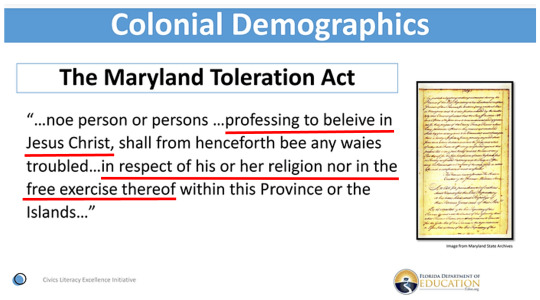

Teaching as FACT That it Is WRONG to Interpret the Constitution as a “Living Document”
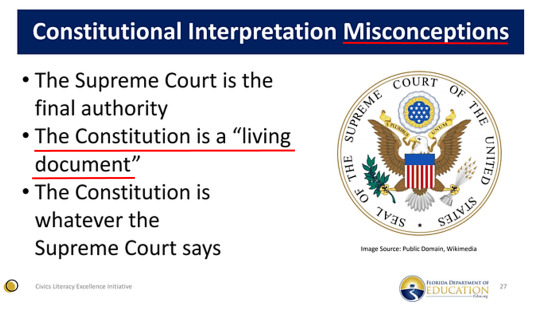
Contrary to what the Florida DE wants to teach, there are excellent arguments to show that the Constitution is a “living document” that can be informed by common law. In addition, consider the Ninth Amendment:
“The enumeration in the Constitution, of certain rights, shall not be construed to deny or disparage others retained by the people.”
The existence of the Ninth Amendment suggests that the Founders understood that not every right could be written into the Constitution, and so they acknowledged that other rights exist.
It would seem that the Florida DE is on the side of the conservative originalists and textualists--who ironically often don’t abide by their own “rules” for interpretation (e.g. the District of Columbia v. Heller decision).
Regardless, how to interpret the Constitution should be the subject of DEBATE and not dictated by the Florida DE.

Playing Down the Negative Peculiarities of American Slavery in the Nation’s Founding
The slides also try to minimize the tragedy of slavery in Colonial America. There are virtually NO slides that show how awful slavery was in our country. And although one slide acknowledged that “2/3 of the Founders held slaves,” the slide made it seem as though the slaveholding Founders weren’t supportive of slavery.

Well, those Founders who didn’t “defend” slavery kept their slaves anyway (although Washington’s will freed his slaves after his death). But here’s a couple of quotes from one of the Founders, Charles Pinckney of South Carolina who defended slavery--and puts the lie to the above slide:
“While there remained one acre of swamp land uncleared of South Carolina, I would raise my voice against restricting the importation of Negroes. I am . . . thoroughly convinced . . . that the nature of our climate, and the flat, swampy situation of our country, obliges us to cultivate our lands with negroes, and that without them South Carolina would soon be a desert waste.”
– Charles Cotesworth Pinckney, South Carolina Ratifying convention, 1788
“They [Africans] certainly must have been created with less intellectual power than the whites, and were most probably intended to serve them, and be the instruments of their cultivation.” – Charles Pinckney, 1821
And the slide below is also misleading:
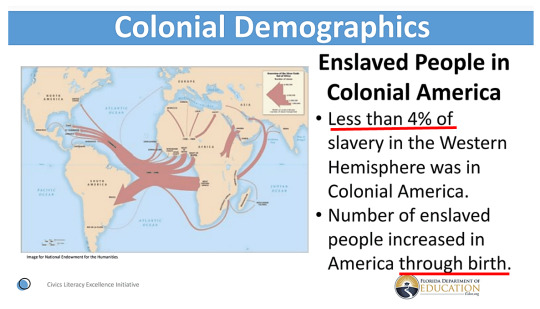
The above slide leaves out a very important fact mentioned in an article on The Gilder Lehrman Institute of American History website:
“Of the 10 to 16 million Africans who survived the voyage to the New World.... only 6 percent arrived in what is now the United States. Yet by 1860, approximately two thirds of all New World slaves lived in the American South.“ [emphasis added]
How could this be that the U.S. started with such a small percentage of slaves from the transatlantic slave trade but had the largest slave population by 1860? Well, the Florida DE hints at it in the above slide when they mention that slave numbers expanded “through birth.”
The numbers of male and female Africans brought to Colonial America were roughly equal; whereas other parts of the Americas had more male slaves. The low birthrates and high death rates of slaves in other regions contributed to their having smaller slave populations by 1860. Also, some parts of the Caribbean, such has Haiti, had abolished slavery as early as 1793.
Another reason, according to The Gilder Lehrman Institute article is that the Spanish and Portuguese were more open to interracial “mixing” with Africans (in part because of few European women) and “recognized a wide range of racial gradations, including black, mestizo, quadroon, and octoroon.” Whereas:
“The American South, in contrast, adopted a two-category system of race in which any person with a black mother was automatically considered to be black.” [emphasis added]
Furthermore, in 1662, chattel slavery was established in colonial Virginia through a law that any child born of a Black female slave (regardless of the race of the father) would be considered a slave. So slavery became based on race and birth in the South. I don’t know if that was the explanation the Florida DE provided of the slide but somehow I don’t think those facts were highlighted.

Look through the slides for yourselves. But to me it is shocking that teaching a right-wing, white “Christian” nationalist view of American history is being ordered by the Florida government.
It is ironic that as academic freedom is being shut down in Florida and other GQP states in favor of right-wing indoctrination, Putin has just started a big push to “indoctrinate” Russian school children with a “militarized and anti-Western version of patriotism.”
It seems to me that creeping right-wing autocracy in GQP states is making them more like autocratic Russia than like American states where academic freedom is still allowed.
[edited]
#florida#us politics#gop#ron desantis#us education#academic freedom#censorship#rewriting history#a right-wing whitewashed christian version of us history and civics#ana ceballos#miami herald#separation of church and state#my edits
141 notes
·
View notes
Text
"For young people that respect is lacking. Young people often are raised without a say in the structures of their lives, starting with public schooling systems that, from the student’s perspective, can be near authoritarian. For them to be told that they can participate in the federal government while also not being trusted to use the bathroom without a permission slip is a contradiction. It breaks the connection between their social structure and their own interests. If they don’t feel empowered in the classroom where they are learning civics, how can they possibly feel empowered in their greater society and government?
"...That cycle of disempowerment can continue throughout life. If those youth never start feeling respected by their social structures, they stay civically disengaged into adulthood."
You can find free and low-cost resources for learning about civics here.
3 notes
·
View notes
Text
I swear if this is a fever I'm having I'm jumping off my window I don't wanna miss those classes 😭
#in “biology” we're doing prehistoric humans I LOVE this topic#in PE this is the last sesson (?) before the final exam and I'm not really.... sporty so this is kind of the last day i can train#in sociology we're doing a revision session for the mock exams in a few weeks#in “EMC” (civic education) I have a presentation and I really like the subject....#UUUUURGG#why TODAY#mes blogs
2 notes
·
View notes
Text
By: Pete Peterson and Jack Miller
Published: Jan 22, 2024
The shocking scenes of college students, faculty, and staff defending Hamas’s October 7th massacre of Israeli civilians as a “legitimate act of resistance” have rightly been called antisemitism.
Our father’s antisemitism was the centuries-old hatred of Jews just because they were Jews, different in their beliefs and customs. But this new form of antisemitism is different, and there are reasons why we’re seeing it revealed on our college campuses today. It’s an antisemitism based on an ideology of the oppressed versus the oppressors, which is also being used against people of other races and ethnicities. Because Israel is seen as strong it is viewed as the oppressor, and Hamas, because it is weaker, is seen as the oppressed.
As two Americans (one Jewish, the other Christian) who are deeply concerned about the future of our country, along with our cherished institutions of higher education, this ideological antisemitism has implications for America as a whole. The antisemitic outbursts at our nation’s colleges and universities are the canary in the coal mine, a warning sign of how this radical worldview regards America, and the West more broadly.
In his book Defending Identity, the legendary Soviet dissident, human rights activist, and Israeli politician Natan Sharansky wrote, “Anti-Semitism has had a unique and astounding staying power, metamorphosing from one epoch to another, one period to another, emerging in different forms to influence different places with different cultural lives.” He concluded by noting, “In each case anti-Semitism has been directed against that conception of identity, of how people defined who and what they are.”
How right Sharansky was. Look at America today, torn apart over which identity group is the most oppressed. But the American motto is “E pluribus Unum” – out of many, one. Instead of bringing us together, this ideological view of the oppressed against the oppressors is tearing our nation apart.
A recent Harvard-Harris poll showed that two-thirds of voters between the ages of 18 and 24 agree that “Jews as a class are oppressors and should be treated as oppressors.” This demonstrates the extent to which this extreme worldview has taken hold in our country. These young people have just recently been through our educational system, which has played a key role in shaping how they think.
We see a strong connection between the ideological capture of K-12 and higher education and the decline in teaching our nation’s founding principles and history in a non-ideological way. American civics and history, rightly taught, is a powerful tool for fighting all “isms,” including antisemitism.
As America approaches its 250th anniversary a growing number of organizations, including the Jack Miller Center and the Pepperdine School of Public Policy, are stepping forward to put a greater emphasis on quality, non-ideological civics and history education. We are seeing some successes with rapidly growing programs that give high school social studies teachers more content through lectures and seminars, as well as the recent launch of civics institutes at a number of public universities, from the University of Florida’s Hamilton Center to the University of Texas’s new Civitas Institute, among others.
Civics education rightly understood counters this new form of antisemitism, and all identitarian philosophies, as it promotes an American “unum” through a non-ideological (yet still critical) teaching of the American project.
Sharansky thoughtfully surmised that, at its root, this is a battle over identity – who we are as American citizens and the future of the American experiment. He wrote in the aforementioned book that “a society without a strong identity is also a society imperiled. The free world’s shield against its enemies is its own identity, vigorously asserted and framed by a commitment to a democratic life.”
The anti-Israel, antisemitic demonstrations on college campuses and in the streets of our cities should be a wake-up call for all Americans. This ideological concept of oppressed versus oppressors that underlies these protests, which brokers no disagreement, is being used against America’s very principles and ideals. Only through a civics education that encourages debate, even as it celebrates the country grounded in the freedom to do so, can we win this battle.
#Pete Peterson#Jack Miller#antisemitism#civics#pro hamas#pro palestine#pro terrorism#islamic terrorism#jihad#islamic jihad#ideological capture#ideological corruption#corruption of education#religion is a mental illness
3 notes
·
View notes